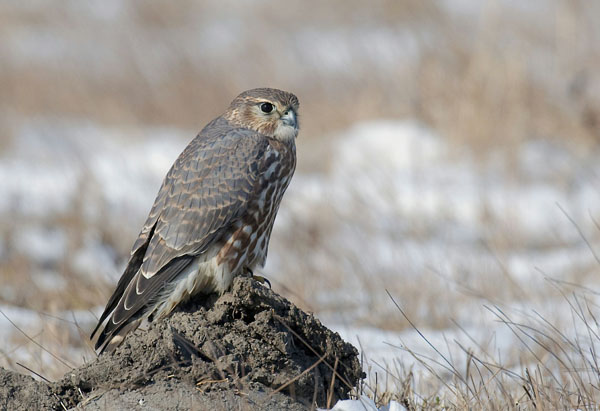Falco columbarius
IUCN
LCBasic Information
Scientific classification
- name:Falco columbarius
- Scientific Name:Gray-backed falcon, gray kite, horse lotus, flower, orchid embroidery, peach blossom
- Outline:Raptor
- Family:Falconiformes Falconidae Falco
Vital signs
- length:25-33cm
- Weight:122-205g
- lifetime:15year
Feature
The Merlin's neck is blue-gray with a tan collar as its unique feature.
Distribution and Habitat
The Gray-backed Falcon breeds in the northwest of China, migrates through the northeast, the eastern coastal areas and most of the central and western regions, and winters in western Xinjiang, south of the Yangtze River and southeastern Tibet. Abroad, it is widely distributed in the central and northern Holarctic, and winters in the southern and southern areas of the Holarctic.
The Gray-backed Falcon likes open habitats, and its activities can often be observed in low mountains and hills below 2,000 meters above sea level, plains at the foot of mountains, and coasts, but it is more likely to appear in forest areas than other falcons. It usually nests in trees or cliffs, occasionally on the ground, and often occupies the old nests of other birds. It often acts alone and has a sharp call.
Appearance
The Gray-backed Falcon is a small bird of prey, with a relatively small body. The wing tips are not sharp, and the wing fingers are more obvious than those of other falcons. When this species flies, its underwing feathers and coverts are densely covered with dark brown spots. The male bird has a bluish-grey back and a bluish head, with bluish sideburns. The chest and abdomen are khaki with brown vertical stripes. The female bird and immature birds are similar to the Kestrel, but are more reddish-brown overall, with more obvious eyebrow stripes and sideburns than the male bird. The abdomen is white with reddish-brown vertical stripes, and the back often has some irregular light spots, which can be distinguished from the red background and black spots of the Kestrel.
Details
The gray-backed falcon often moves alone and has a sharp call. It often flies at low altitudes, and after a quick flap of wings, it occasionally glides briefly, and immediately dives down to prey when it finds food. It rests on the ground or in trees. It mainly feeds on small birds, rodents and insects, and also eats lizards, frogs and small snakes. It mainly hunts in the air and often chases pigeons, so it is commonly known as the "pigeon hawk". Sometimes it also hunts on the ground. The flying temperament is fast and fierce, and it is as fast as lightning when flying in a straight line at low altitude, which is shocking. It often uses this method to attack small birds in a straight line.

The breeding season of the Gray-backed Falcon is from May to July. It usually nests in trees or cliff rocks, and occasionally on the ground. It especially likes to occupy the old nests of crows, magpies and other birds, and sometimes builds its own nest.
The parents take turns to incubate the eggs, and the incubation period is 28-32 days. The chicks are late-maturing, and after hatching, the parents take turns to raise them for 25-30 days before leaving the nest. Older young birds often happily fly into the air to chase fluttering feathers or dandelion inflorescences, and launch mock attacks on these things, which is also their preparation for future hunting careers.
Call: A series of sharp and piercing calls that rise rapidly when used as a warning. Young birds beg for food with a yeee-yeee call.








